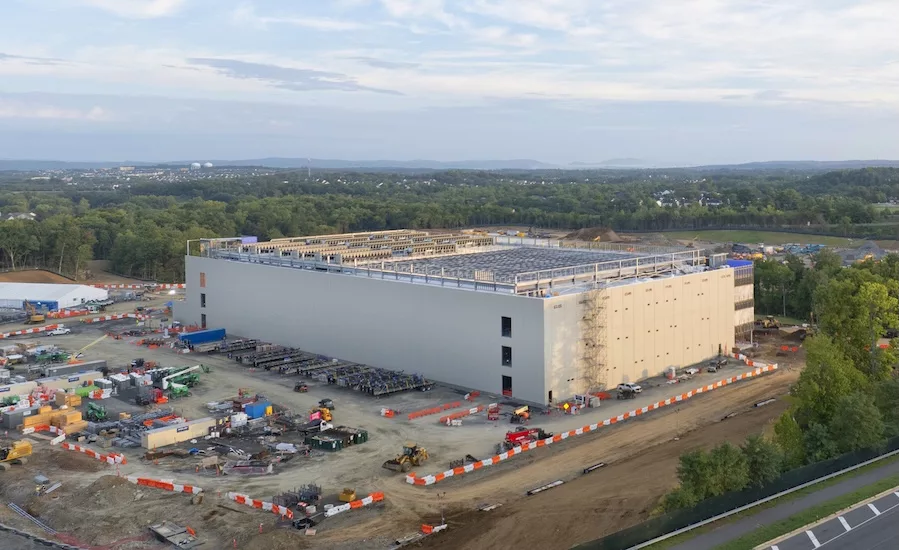Close the Gaps in Data Center Project Insurance Policies, Says Major Contractor
Photo by Gerville/Getty Images
Costs per megawatt, the measure of a data center project such as this one under construction in Ashburn, Va., have risen dramatically in recent years, stretching the limits of insurance coverage.
C ontractors considering a ride into or already riding the data center building surge would do well to sit down for some advice from Chase C. Leist, vice president for insurance and risk management at HITT Contracting, and Jason Romero, chief operating officer of Stealth AI Co.
There are lots of risk-related decisions to make and often in the rush to get work started, little time to consider gaps in coverage.
Several hundred people did sit down with Leist and Romero at the International Risk Management Institute recent construction conference in Indianapolis, Nov. 16-19. They fielded as many questions as the time allowed, but the questions kept coming.
What type of data center cooling system is most cost-effective, air or water-cooled? What is the usual scope of the general contractor regarding server installation and commissioning, and does the general contractor or owner do it? Under an owner-controlled insurance program, how do you determine the limit in the general liability coverage on a large project?
Leist and Romero tried to cover as much as possible in their allotted time and even distributed a glossary of data center terms for audience members.
Unlike other buildings measured in square feet, data centers are described by the amount of critical power needed to run their server racks. Leist said that three years ago the typical data center cost rule-of-thumb was $4 million per megawatt. Now those costs are often between $8 million and $12 million, various sources indicate.
With outsized contracts and costs for tenant improvements, the insurance industry “not surprisingly [has] not been keeping lockstep with the data center industry on capacity,” Leist said. “So you have to make decisions about what is the right total insured value, what is the right limit for your policy or project when you are talking about some of these major mega-campuses.” And you have to let the whole project team know what is covered, she said.
Major financial institutions that fund projects may have their own standard insurance requirements or different supplements to the basic policy. They might include a requirement that there is insurance “for full replacement value.” But when you apply that to a $4-billion to $6-billion project, “there is some clashing” that goes on, said Romero. “The debt community has had to evolve with the insurance community.”
Leist emphasized that the project’s builders risk policy, which covers property damage during construction, must cover all the owner’s-furnished electronic equipment chocked into the building. “Make sure you have that because it’ [the equipment] is very expensive,” she said.
Chase Leist vice president of HITT Contracting. answers some of many questions asked about data center construction insurance at the International Risk Management Institute construction risk conference in Indianapolis Nov. 16-19.
Photo: Richard Korman for ENR
One question submitted by an audience member was about what happens if the builders risk insurance is applied after foundations are in place—but prior to the project “going vertical” and the builders risk coverage is in place—and then the foundations settle.
“Are you seeing foundation exclusions for a claim over work that is completed” but “before the builders risk policy took effect?”
Romero didn’t have a chance to answer that completely, but he did say that builders risk insurance should be in place “no later than floaters and foundations.” Floaters are special insurance provisions that cover property not covered in a standard insurance policy.
When there is a lot of machinery in one place, you “have to look at loss limits” for physical damage and tell the project team what is covered, he added.
There may be “a lot of jousting” about out-of-pocket costs not covered by the policy, Romero said. Different parties to the project may say, “I don’t want to be responsible for a million dollar deductible,” according to Romero.
Watch Out For Big Deductibles
One situation Leist believes could come up is if a subcontractor already lined up for the job balks at a big deductible that the proposed insurance arrangements say the sub must pay. “It’s very difficult for a sub to handle a million-dollar deductible,” she noted. “They might say, ‘I’m not signing my subcontract.’ And we might say, ‘we need you to start on Monday,’ and then they might say ‘too bad.'”
But the best approach, advised Leist, is to equitably divide the risk “so that nobody takes it on the chin” and assure that there is “third-party risk financing so all can go forward” with the project.
Often, Leist and Romero indicated, the data center halls are turned over in phases. “It’s not as simple,” noted Leist, “as if we built an office and the tenant moved in and that was it.”
And forget about a “one-size-fits-all” approach when it comes to negotiating with an owner.
Whether the project insurance should be part of an owner-controlled program or a contractor-controlled program “is very project specific,” said Romero. “All the variables are moving targets [and] I can’t remember a project where the design didn’t change and other things changed with it.”
One promising sign, Leist said, was insurance markets and brokers that are starting to use data center specific standard policy forms and policy endorsements. “Those types of adaptations … are excellent and provide an opportunity to close the loop on data centers when it comes to builders risk.”
Filling in the coverage gaps, she said, is important “because these types of things may not be the same” as with an office building project.
Deputy Editor Richard Korman helps run ENR’s business and legal news and investigations, selects ENR’s commentary and oversees editorial content on ENR.com. In 2023 the American Society of Business Publication Editors awarded Richard the Stephen Barr Award, the highest honor for a single feature story or investigation, for his story on the aftermath of a terrible auto crash in Kentucky in 2019, and in 2015 the American Business Media awarded him the Timothy White Award for investigations of surety fraud and workplace bullying. A member of Investigative Reporters and Editors, Richard has been a fellow on drone safety with the McGraw Center for Business Journalism at the Craig Newmark Graduate School of Journalism at CUNY. Richard’s freelance writing has appeared in the Seattle Times, the New York Times, Business Week and the websites of The Atlantic and Salon.com. He admires construction projects that finish on time and budget, compensate all team members fairly and record zero fatalities or serious injuries.
Information contained on this page is provided by an independent third-party content provider. This website make no warranties or representations in connection therewith. If you are affiliated with this page and would like it removed please contact editor @producerpress.com







